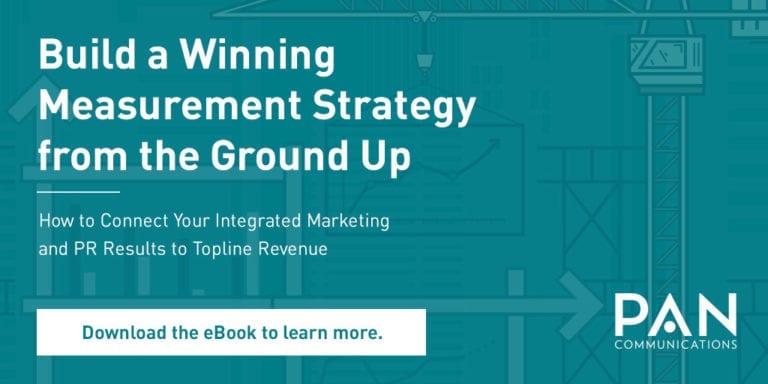Content Marketing Metrics that Matter

This blog is the fourth and final installment in our series that focuses on the five-pillar approach to content marketing. Check back across the series to learn how to bring your content from ideation to execution, and how to measure its impact along the way.
Determining if your content strategy is performing as expected isn’t easy, and without understanding your content’s impact, you’re just making content for content’s sake. Mastering content analytics and identifying content’s specific effect on how you attract and convert new customers is challenging. It takes time to craft the right approach so that you truly measure the metrics that matter. The best rule of thumb is to measure early and measure often.
“It takes time to craft the right approach so that you truly measure the metrics that matter. The best rule of thumb is to measure early and measure often.”
Look to the Data
Even if your content may be performing well, your content marketing strategy may still need adjustments. That’s where data comes in to help optimize your strategy. As you execute your approach and begin to gather analytics on your content, you’ll understand what your audience is responding to the most. Use those insights to your advantage. You can then leverage this to build upon a strategy that’s already working well.
Critical elements of content analytics include:
- Consumption metrics: Page views, unique visitors, bounce rates, time on page, opt-ins, conversions, impressions, open rates, click-throughs
- Sharing metrics: Website, blog, and online assets shares, social shares
- Retention metrics: New and returning visitors, bounce rate, social media follower rates, unsubscribes
- Leads metrics: New titles in pipeline, leads generated by specific content, existing leads engaged with the new content, conversion strength
- Sales metrics: Sales opportunities, revenue, pipeline, organic growth opportunities, shortened sales cycles, lower customer acquisition costs, increased customer satisfaction, higher win rates, strengthened WOM
More than ever, measurement, reporting and analysis are key to a successful content marketing program. However, it’s important that data is presented and interpreted in ways that marketers can effectively put to use in future pieces. While “more” data can be helpful, “good” data is what you really want in order to take the right actions with your writing. For example, good data can illustrate click-throughs from your content deeper into your product pages, or demonstrate engagement rates by how many comments your pieces received or were shared. These are deeper insights that help guide your strategy.

The Content Marketing Metrics that Matter
But what good is data you can’t understand? If you’re not clear on what certain metrics mean or why they are valuable, ask your content team to explain the rationale behind including them. This not only helps you get everyone on the same page, but it encourages them to think through the purpose of each content asset as it relates to your specific business goals.
Marketing teams responsible for brand awareness and increasingly, revenue, are working off similar results, forcing a disciplined review of critical metrics when it comes to the content they build and curate. Data provides common ground for PR, content, demand-gen and sales teams, and common ground leads to success. Thinking about how your content marketing metrics tie into your internal reporting methodology will help you connect the dots between content success and business growth.
“Thinking about how your content marketing metrics tie into your internal reporting methodology will help you connect the dots between content success and business growth.”
We Want YOUR Opinion.
Measuring Success in Syndication
Set up regular touch points with your team to discuss taking top-performing content and pull it across your channels for maximum exposure. For example, if an original article on LinkedIn received an overwhelming response in Q4 – and corresponding insights resonated well with the media – think about how to extend that engagement across the marketing mix. As key audiences begin to recognize your brand through the thought leadership you push into market, invest in creating additional resources to feature on your channels and website, such as blogs, eBooks and position papers, to capitalize on the moment in time.
Knowing how to evaluate your content and ask the right questions about its performance will yield deeper insights you can funnel back into the assessment phase and drive further success. Just remember to keep content fresh, focus on topics vs. keywords, address user intent and track the journey of your visitors through your content and brand engagement.
If you’re interested in learning more generally about integrated marketing and PR measurement beyond your content program, download PAN’s eBook: Build a Winning Measurement Strategy from the Ground Up. By downloading the report, you’ll unlock a more holistic view when it comes to integrated measurement and a clear definition of what it means to align brand goals with your audiences’ cravings in terms of channel delivery and content.
We hope you enjoyed our four-part blog series on content marketing! Throughout the series we discussed all-things modern content marketing as part of a comprehensive, digitally agile framework PAN developed to serve as the cornerstone of your CM strategy. Data-driven and customer-centric, our five-pillar approach not only helps brands identify which content excites its audiences most but also answers why they are so hungry for it.
